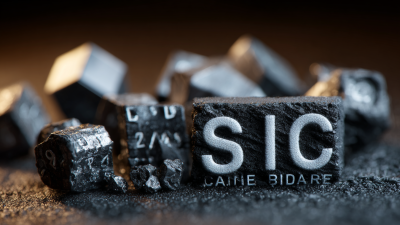Leave Your Message
In recent years, Silicon Carbide Substrate has emerged as a pivotal material in various high-performance applications, owing to its remarkable physical and electrical properties. This compound semiconductor possesses excellent thermal conductivity, wide bandgap, and high breakdown voltage, making it an ideal choice for power electronics, high-frequency devices, and even optoelectronics. Selecting the best Silicon Carbide Substrate for a specific application is crucial to optimize performance and efficiency. Factors such as substrate orientation, surface roughness, and thickness must be carefully considered to ensure compatibility with the intended electrical or thermal applications.

Understanding the various types of Silicon Carbide Substrates available and their unique characteristics can significantly impact the success of your project, from designing cutting-edge electronic components to developing advanced energy-efficient devices. This article aims to provide a comprehensive guide on how to choose the most suitable Silicon Carbide Substrate tailored to your application needs.
Silicon carbide (SiC) substrates play a crucial role in high-performance applications, particularly in power devices and electronic components. Their exceptional thermal conductivity, wide bandgap, and high electric field breakdown strength make them ideal for demanding environments where traditional materials may falter. This has led to a significant increase in the adoption of SiC substrates across industries such as automotive, aerospace, and telecommunications, where efficiency and reliability are paramount.
The importance of selecting the right SiC substrate cannot be overstated, as it directly impacts the performance and longevity of the final product. Different applications may require specific properties, such as surface roughness or defect density, which are influenced by the substrate's fabrication process. Recent advancements, including the development of high-strength amorphous SiC and tailored polycrystalline substrates, have further expanded the possibilities for SiC applications. As the market evolves, understanding these nuances is essential for manufacturers looking to leverage SiC technology effectively.
 The ongoing miniaturization trend in the electronics industry is reshaping the design
and manufacturing of printed circuit boards (PCBs). As consumer demands evolve toward
smaller, more powerful, and feature-rich devices, selecting the appropriate
silicon carbide substrate becomes critical.
The choice of substrate influences the performance, reliability, and thermal management
of the final product.
The ongoing miniaturization trend in the electronics industry is reshaping the design
and manufacturing of printed circuit boards (PCBs). As consumer demands evolve toward
smaller, more powerful, and feature-rich devices, selecting the appropriate
silicon carbide substrate becomes critical.
The choice of substrate influences the performance, reliability, and thermal management
of the final product.
When selecting a silicon carbide substrate, there are several key factors to consider.
First, assess the thermal conductivity required
for your application. High thermal conductivity ensures efficient heat dissipation, which
is essential for maintaining performance and longevity. Second, pay attention to the
crystal quality of the substrate. A high-quality crystal
structure can significantly enhance electronic properties, leading to improved device
efficiency and lower defect rates.
Tips: Consider the specific
requirements of your application, such as operating frequency and power levels, when choosing
the substrate. Additionally, be aware of the compatibility of the substrate with other materials
used in the PCB. This can affect adhesion and overall performance, so carefully evaluate all
material interactions before making your final selection.
Silicon carbide (SiC) substrates have gained prominence in various applications, particularly in
high-power and high-temperature devices. The choice between different types of SiC substrates, such as
4H-SiC and 6H-SiC, can significantly influence the performance
and efficiency of semiconductor devices. 4H-SiC, known for its superior electron mobility and lower defect density, is often preferred
for high-frequency applications. In contrast, 6H-SiC may offer advantages in certain thermal and optical applications due to its unique
crystal structure.
Furthermore, the growth method and substrate quality can also affect device outcomes. Arom et al. have demonstrated that substrates grown via
epigraphic methods often exhibit fewer defects, leading to enhanced device reliability and performance. Another critical aspect is the
thickness of the SiC substrate; thicker substrates may provide better thermal management but could also introduce additional mechanical stress.
Ultimately, a comprehensive understanding of the specific application requirements, along with information on the distinct characteristics of
various SiC substrates, remains essential for optimizing device design and functionality.
When selecting the best silicon carbide (SiC) substrate for your application, evaluating the cost-effectiveness and performance is essential. According to a recent market analysis by Allied Market Research, the global SiC substrate market is expected to reach $1.2 billion by 2026, driven by demand in automotive and power electronics sectors. This projection underlines the growing significance of SiC in high-performance applications, highlighting the need to assess not just the upfront costs but the long-term value and efficiency gains these substrates can provide.
For instance, while some high-quality SiC substrates may have a higher initial price, they can lead to lower operating costs and increased reliability over time. A study published in the Journal of Electronic Materials indicates that the thermal conductivity of SiC can be up to 3.2 W/cmK, which significantly outperforms traditional silicon options. This performance translates into better heat dissipation and higher efficiency in power devices, making it a critical factor when considering your investment in SiC technology.
**Tips:**
1. Always compare the total cost of ownership (TCO) of different SiC substrates, factoring in performance metrics such as thermal conductivity and breakdown voltage, which can affect longevity and maintenance costs.
2. Keep abreast of technological advancements and vendor reliability, as these can influence both performance and cost. Leverage industry reports to guide your purchasing decisions.
The ongoing shift toward 8-inch silicon carbide (SiC) substrates is indicative of a growing demand in various industries, particularly within electric vehicle (EV) powertrains. As power device technology evolves, traction inverters are benefiting significantly from the enhanced performance characteristics that SiC offers, such as better efficiency and thermal management. This advancement supports the rapid expansion of the electric vehicle market, enhancing battery life and reducing charging times, which are critical factors for consumer adoption.
Tips for selecting the right SiC substrate for your application include evaluating the substrate's thermal conductivity and electric field strength, as these properties directly impact device performance. Moreover, consider the compatibility of the SiC substrate with your existing fabrication processes to minimize production disruptions.
As SiC technology matures, there are concerns about it potentially becoming a commodity. This shift could affect pricing and supply chain dynamics. To stay ahead, manufacturers should invest in innovative processes to differentiate their products and leverage the unique benefits of SiC, ensuring they maintain a competitive edge in an evolving market landscape.







